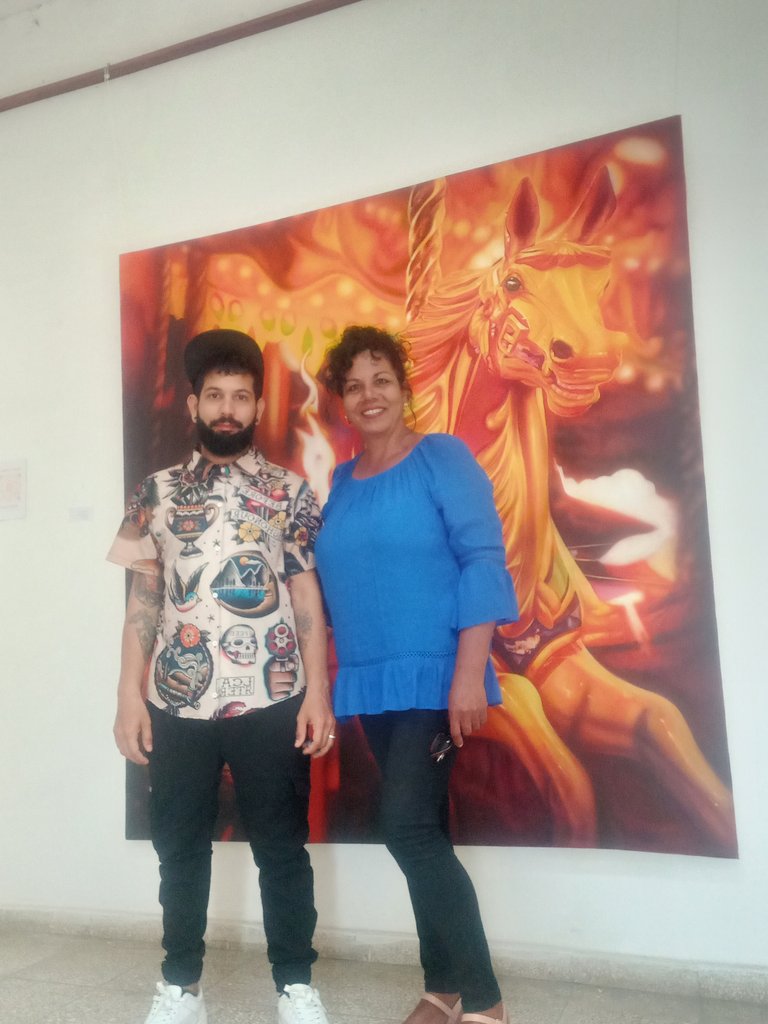
Con Luis Antonio González, artista visual.
Las últimas cenizas, del artista visual Luis Antonio González Rodríguez, inaugurada el viernes 14 de marzo en la galería Uneac en la ciudad de Las Tunas, Cuba.Un saludo para los amigos de esta comunidad @CelfMagazine, quiero contarles sobre la exposición
La exposición se ve poderosa, la frase que da la bienvenida es parte del texto del catálogo (invitación y catálogo muy bien diseñados), escrita además por Pedro Gómez. ¿Quién es Pedro Gómez? Nadie sabe, somos todos. Todos los que por estos lares, alguna vez hemos escrito una palabra sobre crítica de arte, ha sido señalado como Pedro Gómez. Él con sus textos ha venido a dinamizar el pensamiento en torno al arte y los procesos culturales, desde las redes sociales con el rostro del "Hijo del hombre " de René Magritte.
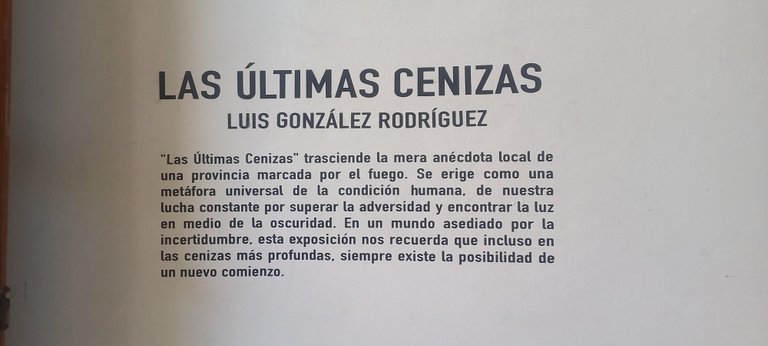
Lo más notorio es que muchos queremos ser Pedro Gómez, tiene una manera muy suya de decir lo que piensa, sí porque lo que sí está claro es que detrás de ese nombre debe existir un ser humano porque la Inteligencia Artificial no nos conoce tan bien como él.
Seguramente Pedro estuvo allí en la exposición de Luis Antonio, escuchó las palabras que hizo para el catálogo y vio el impacto de las obras en el público.
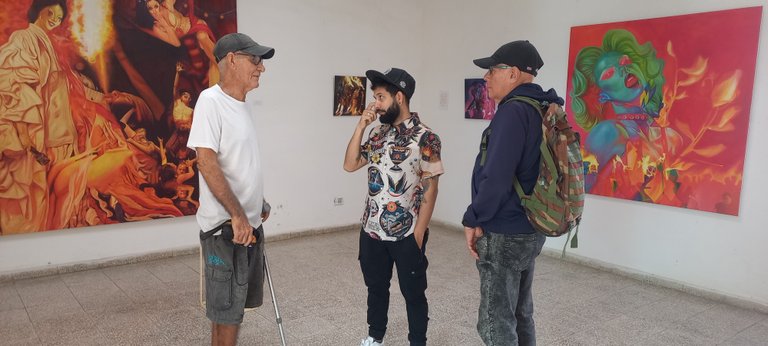
Dice Pedro Gómez que "Las últimas cenizas", trasciende la mera anécdota local de una provincia marcada por el fuego. Se erige como metáfora universal de la condición humana, de nuestra lucha constante por superar la adversidad y encontrar la luz en medio de la oscuridad.
Pero es inevitable deshacerse de ese pasado enraizado en la historia de una isla, esta ciudad fue quemada tres veces; algunas obras hablan de cenizas, de caballos mutilados, de llamas y héroes desafiantes. Por supuesto que quiera el artista o no, el que sabe de ciudades en llamas, coteja su información con las imágenes allí expuestas.
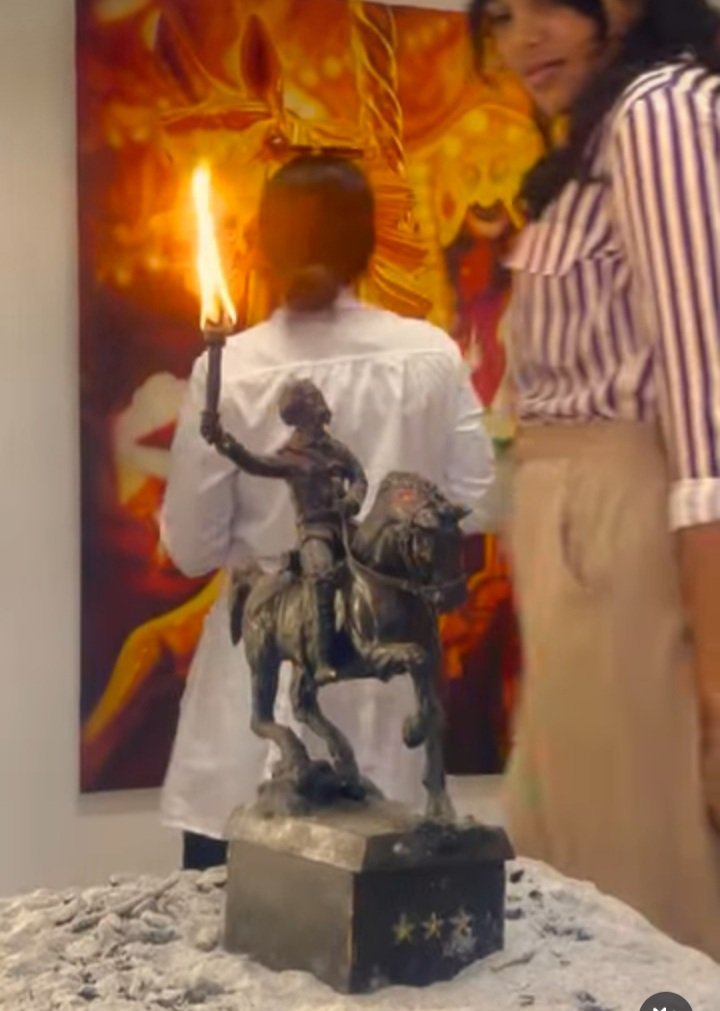
En esta imágen puede verse el efecto de las llamas reales que sólo se empleó en el momento de apertura y primer impacto con el público. Fuego proveniente de la miniantarcha que compone una de las piezas escultóricas representativa del héroe local.
Allí la historia y el presente aliñados con un pasado arrasador, me supo a circo. Inmensas composiciones que atrapan por el naranja y las dimensiones nos hacen el recuento de mujeres tragafuegos como si ellas fueran figuras invisibles ayer y aparecidas hoy para demostrar que la historia no es como la cuentan.
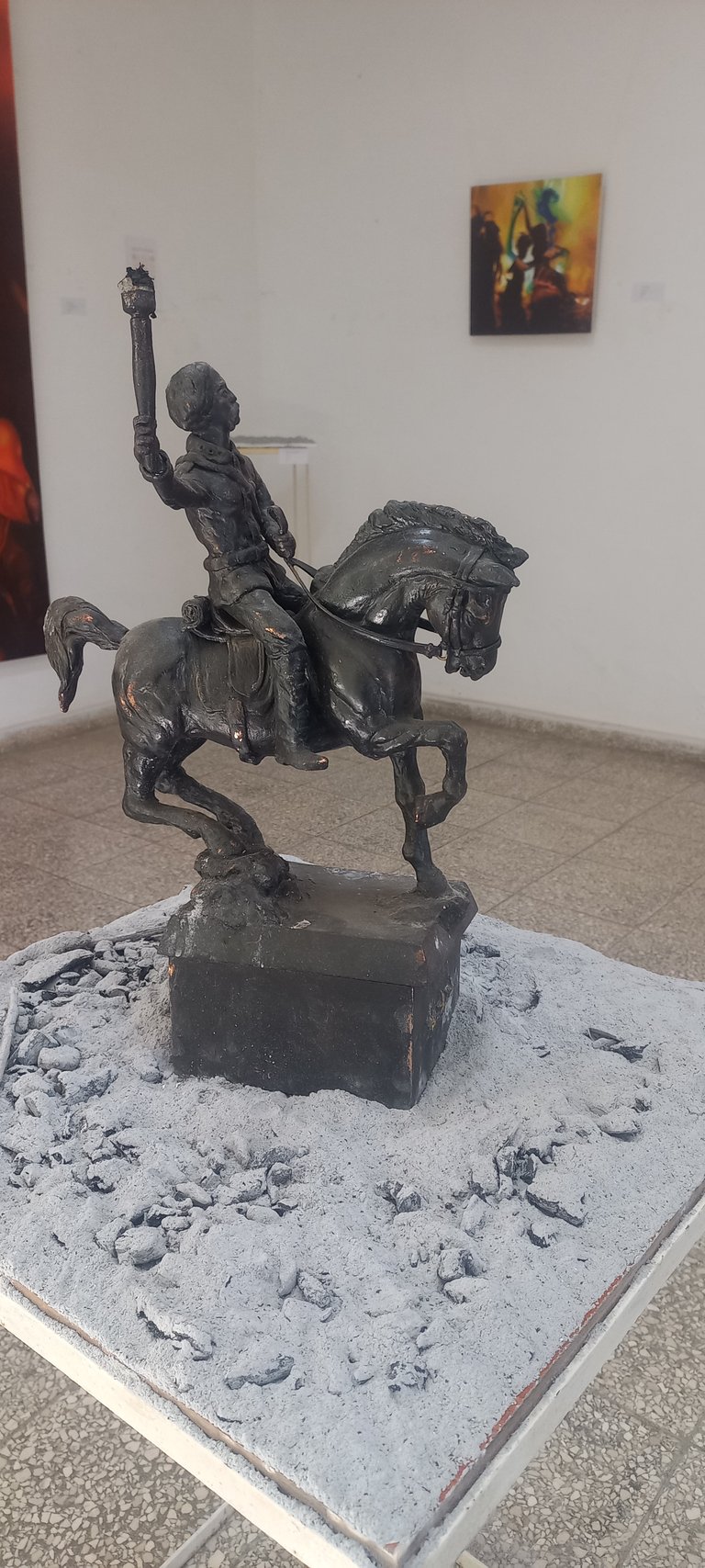 | 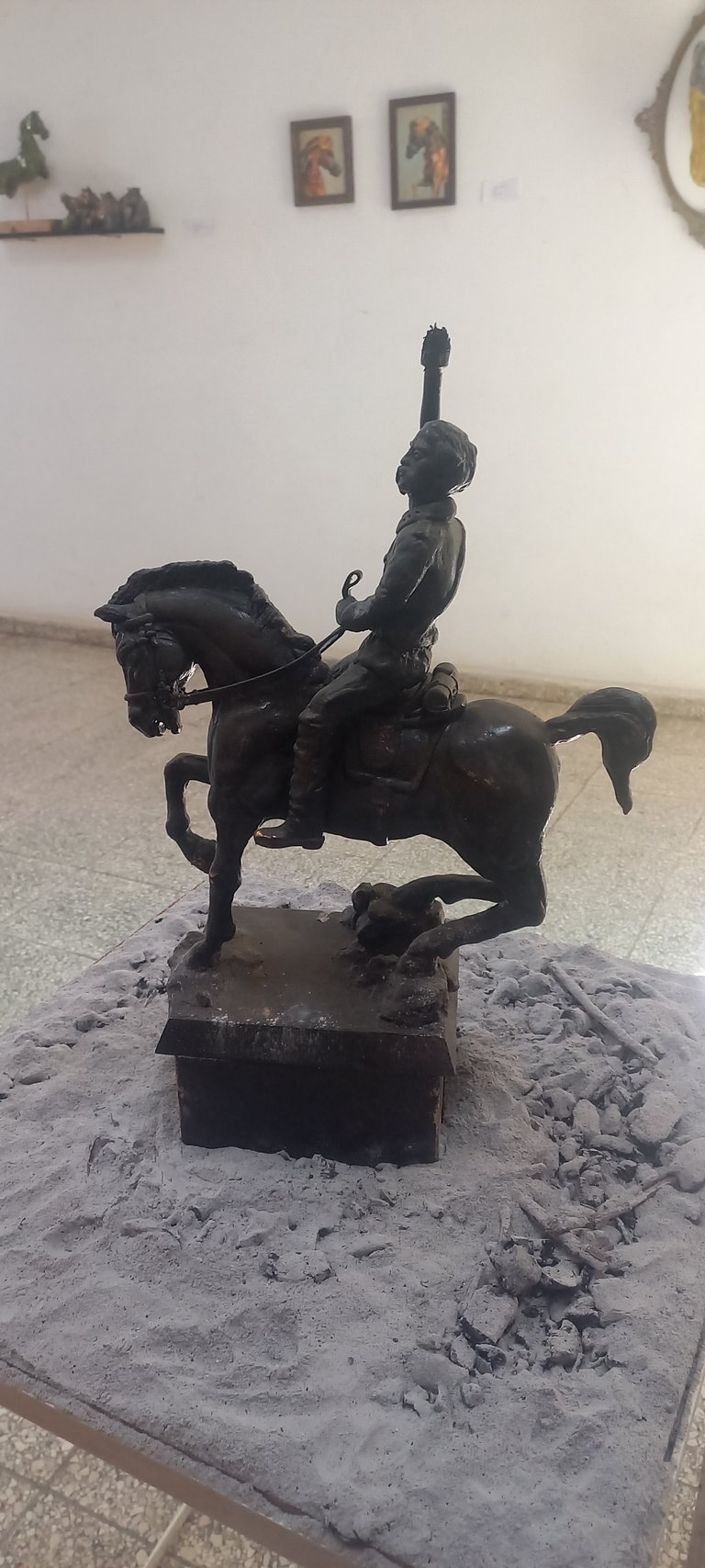 |  |
|---|
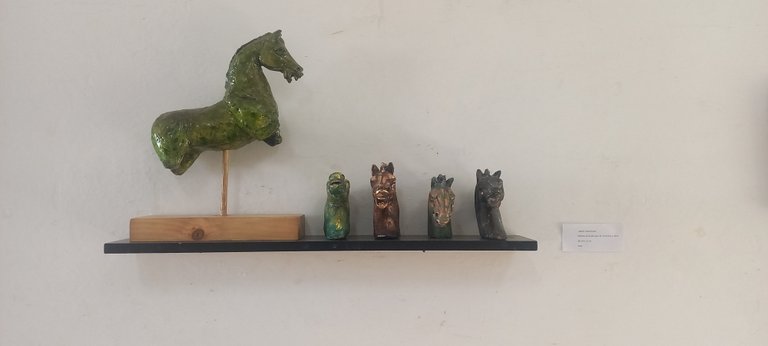
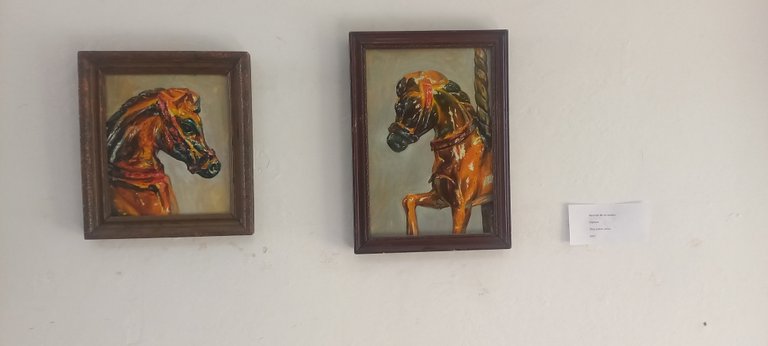
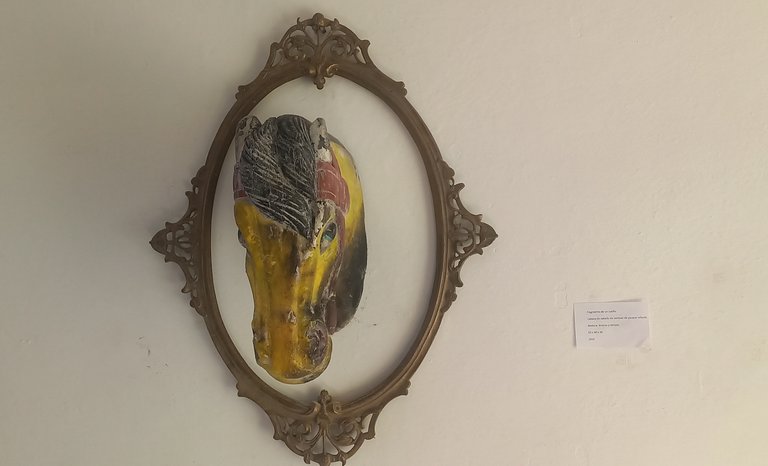
Luis Antonio hace uso de la técnica escultórica con la alegoría de las figurillas de yeso. Esto no me lo dijo el artista, yo lo acomodo en función de una sociedad que se ha conformado con poco o lo simple, que se conforma con lo que otros deciden. En cada pieza demuestra calidad tecnica y conceptual con la sátira.
Y vuelvo otra vez a Pedro Gómez porque en todo este panorama él es una obra más en la exposición, es un intetrexto, una información subliminal porque debemos aprender que cada uno ha de hacer la historia y formar sus héroes; prender, tragar y apagar sus fuegos y aunque no sea un ente visible, se puede dejar huellas.
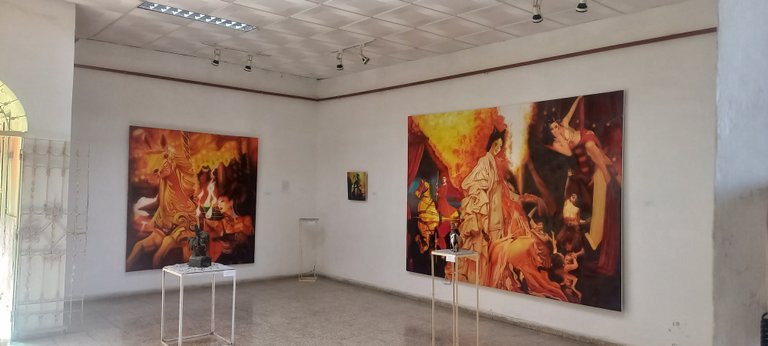
La exposición está conformada por 10 pinturas de diferentes dimensiones y 5 esculturas de pequeño formato, distribuidas en una concepción curatorial discursiva, de la cual no quieres salir. La museografía, pese a todos los no que sufrimos hoy en el país, es un logro pues la sala cuenta con luces y un ambiente físico impecable.
Algunos preguntan a Luis Antonio el significado de su obra, a lo cual no está obligado a responder pues cada espectador reacciona y dialoga con la obra según el conocimiento y emociones contenidas. Aún así el artista refiere que "El concepto general de la expo es el fuego como catalizador de transformación, donde exploro la “hipótesis de la adversidad” que postula la necesidad de experimentar crisis o desafíos para alcanzar la fortaleza y el desarrollo personal máximo".

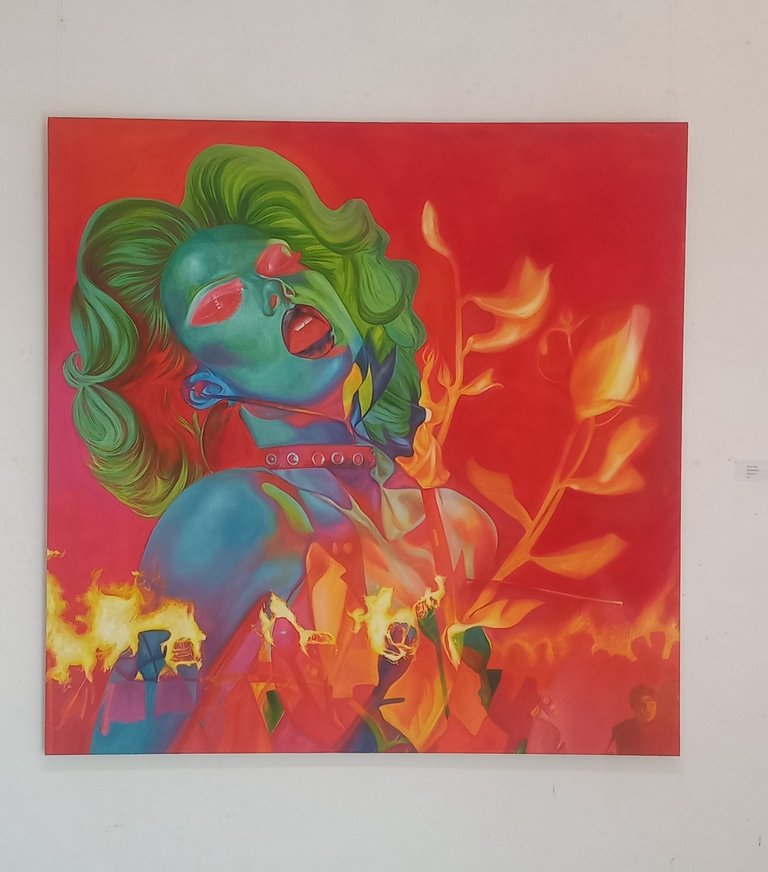

Y esa es su intención que parezcan restos que quedaron luego del fuego. Uno de los símbolos mas recurrentes son los carruseles, imagen que forma parte del acervo infantil; "quemados representan la pérdida de la inocencia y la alegría".
La atmósfera naranja, por la alusión al fuego, a través de las mujeres en el acto de tragar "candela", simbolizan la fuerza y la capacidad de transformar la destrucción en belleza. Representa esa fuerza transformadora. Su danza con el fuego es una metáfora de la capacidad de convertir el dolor en arte y en esperanza, refiere el artista.
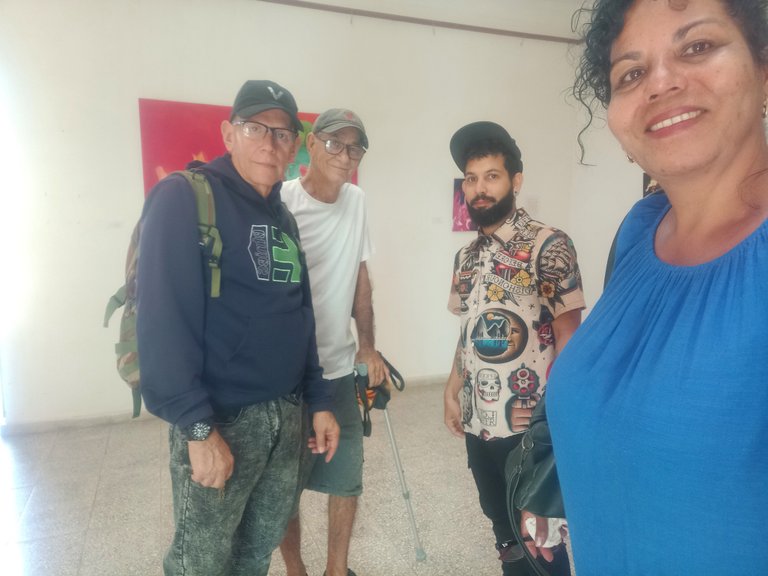
Hay mucho que descifrar en Las últimas cenizas., llégate a verla.
https://instagram.com/p/DHZjIY1CWiJ/
This post was written and documented by me, and the images used are my own.Thank you for visiting my blog. I'm an art critic and social researcher who loves cooking. I invite you to learn more about me, my country, and what I write.

The last ashes

With Luis Antonio González, visual artist.
The last ashes, the exhibition by visual artist José Antonio González Rodríguez, which opened on Friday, March 14th, at the Uneac gallery in Las Tunas, Cuba.Greetings to the friends of this community @CelfMagazine, I want to tell you about
Today, with fewer visitors, the exhibition looks powerful; a phrase welcomes us. The phrase is part of the catalog text (very well-designed invitation and catalog), also written by Pedro Gómez. Who is Pedro Gómez? Nobody knows; it's all of us. from social media with the face of René Magritte's "Son of Man."
Everyone in these parts who has ever written a word about art criticism has been referred to as Pedro Gómez. With his texts, he has come to energize thinking about art and cultural processes.

The most notable thing is that many of us want to be Pedro Gómez. He has a very distinctive way of expressing his thoughts, yes, because what is clear is that behind that name there must be a human being, because Artificial Intelligence doesn't know us as well as he does.
Surely Pedro was there at Luis Antonio's exhibition, heard the words he wrote for the catalog, and saw the impact the works had on the public.

Pedro Gómez says that "Las última cenizas" transcends the mere local anecdote of a province marked by fire. It stands as a universal metaphor for the human condition, for our constant struggle to overcome adversity and find light in the midst of darkness.
But it's inevitable to let go of that past rooted in the history of an island. This city was burned three times; some works speak of ashes, mutilated horses, flames, and defiant heroes.
Of course, whether the artist wants to or not, those who know about burning cities compare their information with the images on display.

In this image, you can see the effect of real flames, which was only used at the opening and first impact on the public.
Fire coming from the miniature antarcha that makes up one of the sculptural pieces representative of the local hero.
There, history and the present, seasoned with a devastating past, felt like a circus to me. Immense compositions captivating with their orange and scale, recount the fire-eating women as if they were figures invisible yesterday and appearing today to demonstrate that history isn't as it's told.
Luis Antonio uses sculptural techniques with the allegory of plaster figurines. This wasn't told to me by the artist; I adapt it to reflect a society that has settled for little or nothing, that settles for what others decide.
In each piece he demonstrates technical and conceptual quality with satire.
 |  |  |
|---|



And I return to Pedro Gómez again because in this whole panorama, he is just another work in the exhibition; he is an intertext, a subliminal piece of information, because we must learn that each of us must make history, form our heroes, ignite, swallow, and extinguish our fires, and even if he is not a visible entity, he can leave his mark.
The exhibition consists of 10 paintings of different sizes and 5 small-format sculptures, arranged in a discursive curatorial conception from which you won't want to leave. The museography, despite all the "no's" we suffer today in the country, is an achievement, as the room has impeccable lighting and a physical environment.

Some ask Luis Antonio the meaning of his work, to which he is not obliged to answer, as each viewer reacts and interacts with the work according to their knowledge and contained emotions. Even so, the artist states that "The general concept of the exhibition is fire as a catalyst for transformation, where I explore the 'hypothesis of adversity,' which postulates the need to experience crises or challenges to achieve strength and maximum personal development."
And that is his intention to make them look like the remains left behind after a fire. One of the most recurring symbols is the carousel, an image that is part of the children's collection; "burned, they represent the loss of innocence and joy."



The orange atmosphere, due to the allegory of fire, through the women in the act of swallowing the "candle," symbolizes strength and the ability to transform destruction into beauty. It represents that transformative force. Her dance with fire is a metaphor for the ability to turn pain into art and hope, the artist reinforces.

There's a lot to unpack in The Last Ashes., go see it.
https://instagram.com/p/DHZjIY1CWiJ/
This post was written and documented by me, and the images used are my own.Thank you for visiting my blog. I'm an art critic and social researcher who loves cooking. I invite you to learn more about me, my country, and what I write.

Good
Gracias ♥️
Hasta allí llegué y valió la pena. Gracias por tu mirada de Crítica de arte.
Mira, que interesante. Gracias por esta sorpresa. No tuve espacio para todos los detalles, si te fijas en tu foto aparece un QR, una via directa para saber más del proceso.
Interesante obra que nos regalas.
¡Gracias!
Interesante la exposición, una lástima que la pueda conocer solo por fotos... O mirándolo de otra forma, gracias a tus fotos puedo conocerla.
!BBH
Gracias ♥️
Congratulations @iriswrite! You have completed the following achievement on the Hive blockchain And have been rewarded with New badge(s)
You can view your badges on your board and compare yourself to others in the Ranking
If you no longer want to receive notifications, reply to this comment with the word
STOP¡Que magnífico que pudieras asistir a esta exposición! 😍 Las obras de éste artista se ven fabulosas y me fascina su punto en donde el espectador sea quién interprete sus obras, esa es una de mis partes favoritas a la hora de ir a exposiciones: La búsqueda interna de las emociones que se conectan con lo observado ✨
Sin lugar a dudas, el fuego es un elemento poderoso, ya que no solamente se asocia a la destrucción, sino a la transformación, aquello que es necesario que pase por un proceso para sacar a relucir su verdadero valor y el artista visual logra con su cometido en ésta exposición 😌
Muchas gracias por mostrarnos tu experiencia 😇💚
Gracias a ti por llegarte a mi blog. Un placer